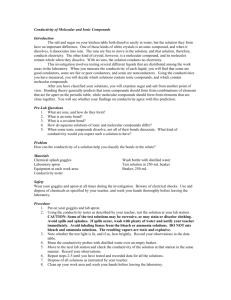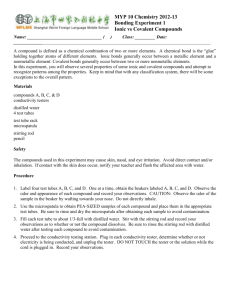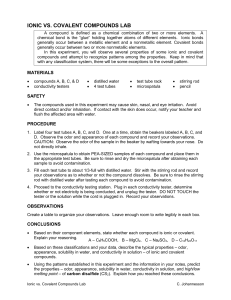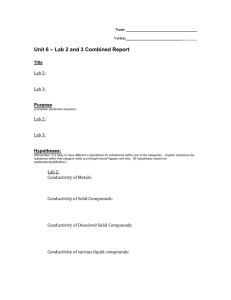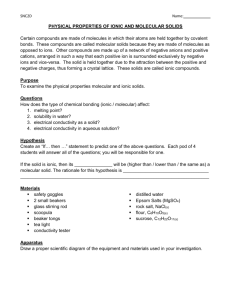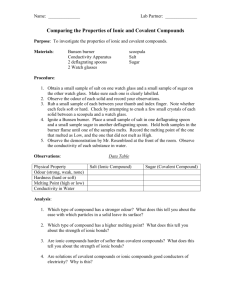EXPERIMENT 10: Electrical Conductivity
advertisement
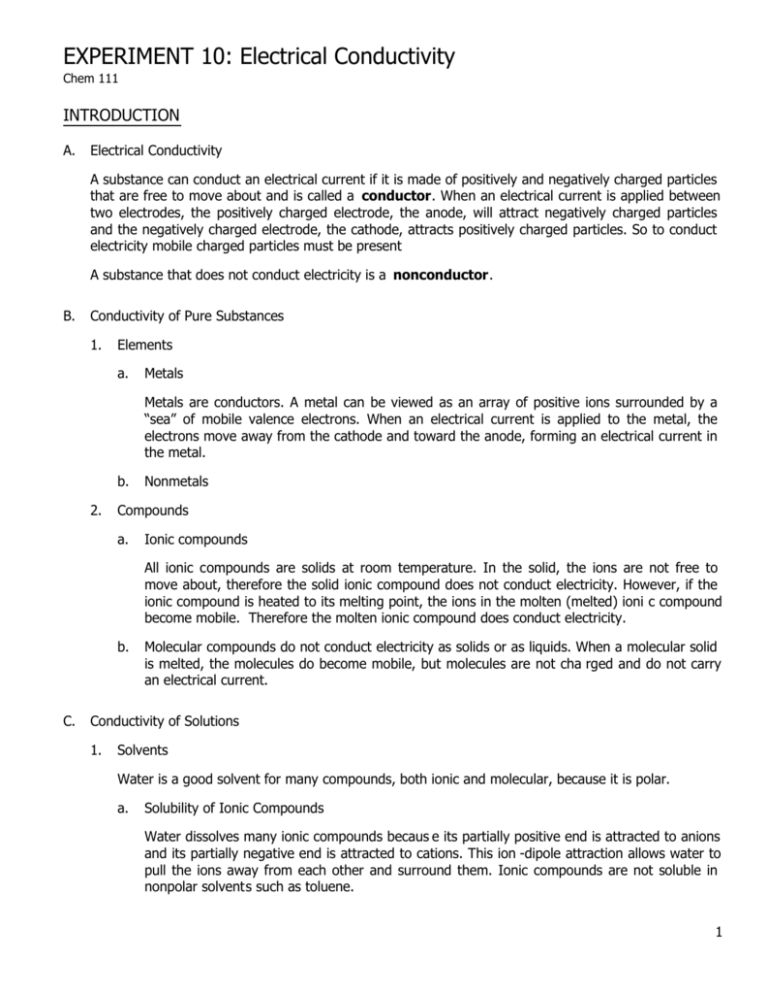
EXPERIMENT 10: Electrical Conductivity Chem 111 INTRODUCTION A. Electrical Conductivity A substance can conduct an electrical current if it is made of positively and negatively charged particles that are free to move about and is called a conductor. When an electrical current is applied between two electrodes, the positively charged electrode, the anode, will attract negatively charged particles and the negatively charged electrode, the cathode, attracts positively charged particles. So to conduct electricity mobile charged particles must be present A substance that does not conduct electricity is a nonconductor. B. Conductivity of Pure Substances 1. Elements a. Metals Metals are conductors. A metal can be viewed as an array of positive ions surrounded by a “sea” of mobile valence electrons. When an electrical current is applied to the metal, the electrons move away from the cathode and toward the anode, forming an electrical current in the metal. b. 2. Nonmetals Compounds a. Ionic compounds All ionic compounds are solids at room temperature. In the solid, the ions are not free to move about, therefore the solid ionic compound does not conduct electricity. However, if the ionic compound is heated to its melting point, the ions in the molten (melted) ioni c compound become mobile. Therefore the molten ionic compound does conduct electricity. b. C. Molecular compounds do not conduct electricity as solids or as liquids. When a molecular solid is melted, the molecules do become mobile, but molecules are not cha rged and do not carry an electrical current. Conductivity of Solutions 1. Solvents Water is a good solvent for many compounds, both ionic and molecular, because it is polar. a. Solubility of Ionic Compounds Water dissolves many ionic compounds becaus e its partially positive end is attracted to anions and its partially negative end is attracted to cations. This ion -dipole attraction allows water to pull the ions away from each other and surround them. Ionic compounds are not soluble in nonpolar solvents such as toluene. 1 b. Solubility of Molecular compounds The “rule of thumb” for the solubility of molecular compounds is “like dissolves like”. This means that polar compounds dissolve in polar solvents and nonpolar compounds dissolve in nonpolar solvents. Water is a good solvent for polar compounds. (Toluene, a nonpolar solvent, is a good solvent for nonpolar compounds.) Water pulls the polar molecules away from each other and surrounds them. 2. Electrolytes and Nonelectrolytes A compound that dissolves in water to form an electrically conducting solution is called an electrolyte. A compound that dissolves in water to form an nonconducting solution is called a nonelectrolyte. A compound that dissolves in water to give a solution that conducts strongly i s called a strong electrolyte and one that dissolves in water to give a solution that conducts weakly is called a weak electrolyte. a. Soluble Ionic Compounds When ionic compounds dissolve in water their ions dissociate (are separated from each other and then surrounded by water molecules). H2 O NaCl (s) Na+(aq) + Cl(aq) Solutions of ionic compounds conduct strongly, therefore soluble ionic compounds are strong electrolytes. b. Soluble Molecular Compounds When molecular compounds dissolve in water their molecules dissociate (separated and surrounded by water). For example, sucrose (table sugar): H2 O C 12H22O11(s) C12H22O11(aq) The molecules in the solution do not conduct electricity, therefore most molecular compounds are nonelectrolytes. However, there are some molecular compounds whose solutions conduct electricity because the molecules chemically react with water to form ions. The two class es of molecular compounds that undergo this Ionization Reaction are the acids and the nitrogenous bases. (1) Acid Solutions In an aqueous solution of an acid, the dissolved molecules react to form ions: HA (aq) + H2O(l) H3O+(aq) + OH(aq) It is a strong acid if all of its molecules react to form ions. Because its solution conducts strongly, it is a strong electrolyte. In a solution of a weak acid only a small fraction of its molecules react to form ions thus giving a solution that conducts only a little. Therefore weak acids are weak electrolytes. (2) Nitrogenous Base Solutions Nitrogenous bases are weak electrolytes. Few of their dissolved molecules react to form ions, so the solution conduct s weakly. For example, NH 3. NH 3(aq) + H2O(l) NH4+(aq) + OH(aq) 2 AQUEOUS SOLUTIONS OF COMPOUNDS TYPE OF COMPD PARTICLES COMPOUND MADE OF I O CLASS OF COMPOUND CRITERIA FOR SOLUBILITY IN WATER SALT Cation is from group IA, NH 4+, Anion is C2H3O2- NO3Anion is Cl- , Br-, I-, or SO42-, with exceptions Anion is CO32- , PO43-, CrO42-, or S2-, with exceptions IONS SOLUTE PARTICLES (MOLECULES) UNDERGO IONIZATION REACTION WITH WATER COMPOUND DESCRIPTION SOLUTE PARTICLES PRESENT IN SOLUTION Soluble ions no Soluble Salt ions only ____ ____ Insoluble I METAL HYDROXIDE C NITROGENOUS BASE M O L Cation is from Group IA or is Ca2+, Sr2+, Ba2+ Soluble All the rest of the metal hydroxides Insoluble Polar Polar ions no ____ ____ Soluble molecules NH3 yes (very little) Soluble molecules MOLECULES Nonpolar Insoluble ___ U A R Strong Base (soluble metal hydroxide) Insoluble Metal Hydroxide Weak Base NH3 Polar Covalent COVALENT E L Insoluble Salt STRONG, WEAK, OR NONELECTROLYTE ____ METAL OXIDE N C SOLUBILITY IN WATER SOLUTE PARTICLES RESULTING FROM DISSOCIATION IN WATER UPON DISSOLVING ACID Polar (all acids are polar) Soluble ___ Nonpolar Covalent yes (100%) HCl, HBr, HI, Strong Acid HNO3 , H2SO4, HClO4 molecules yes (very little) Weak Acid ions only ___ molecules (plus a few ions) molecules only ___ ions only molecules (plus a few ions) 3 PROCEDURE CAUTION: Glacial acetic acid is corrosive and will burn the skin. If skin contact occurs, the contacted area should be washed with large amounts of water. It also has a strong odor and should be kept away from the nose while testing it. When finished, it is to be flushed with lots of water into the large sink before, while and after it is emptied. A. Conductivity DEMONSTRATION BY INSTRUCTOR Your instructor will test the conductivity of some substances and solutions using the light bulb conductivity apparatus. The conductivity apparatus will be plugged into an electrical outlet. When the electrodes are placed in the material being tested, the light bulb will light if mobile ions are present. If the light bulb lights bri ghtly, the material is a strong conductor (lots of mobile ions present to conduct the current) . If the bulb lights only dimly , it’s a weak conductor (relatively few mobile ions present). If the bulb does not light at all, the material is nonconducting (no mobile ions). Record your observations on your Report Sheet. 1. Test the conductivity of tap water 2. Test deionized water. 3. Observe the conductivity of pure acetic acid, HC 2H3O2(l). There is no solvent present. (This pure liquid is also called “glacial” ac etic acid because its freezing point ( 16.7°C) is just slightly below room temperature.) 4. The conductivity of a solution of HCl dissolved in toluene (a nonpolar solvent) will be tested. 5. Water (a polar solvent) will be added to the HCl/toluene solution and the mixture stirred. Water and toluene are immiscible and will form two layers. Toluene is less dense than water so it forms the upper layer and water the lower. The electrodes will be placed below the toluene layer and into the water layer to test it s conductivity. ALL MIXTURES CONTAIN ING TOLUENE WILL BE HYDROCARBONS” CONTAINER. B. DISPOSED OF IN THE “ HALOGENATED Students’ Measurements of Conductivity Students will work in pairs for this part of the experiment. Each pair will check out the following from the stockroom: LED Conductivity Indicator (Fragile! Handle with care.) Spot plate (You cannot use the spot plate in your locker.) Oval well for deionized water (for rinsing electrodes between tests on liquid samples) 4 The material to be tested is placed in a well of the spot plate. When the electrodes are immersed in th e test sample, you will get one of three responses. You may need to shade the LED (light emitting diode) indicator from the bright overhead lights in the lab with your hand in order to see the response. (Alternatively, your instructor may turn off some of the lights in the lab.) Also, it is best to view the LED indicator by looking down on it from above. LED Indicator Response 1. 2. Type of Conductor bright red light (blinking or not) strong conductor dim red non-blinking light weak conductor no light non-conductor Conductivity of Ionic Compounds and Metals a. Take your clean, dry spot plate to the reagent bench and add solid NaCl to one of the wells of the spot plate until it is about half full. At your bench, test the test the conductivity of the NaCl by immersing the tips of the electrodes in it. Record your observation on your report sheet. b. Take your conductivity indicator to the reagent bench where you will find a card with strips of Cu, Zn and Sn attached to it. Test the metals for conductivity by touching the electrodes to each of the metals. Record your observations on your report sheet. Conductivity of Solutions a. Take the clean, dry spot plate to the reagent bench. Place about 16 drops of each of the solutions listed below in a separ ate well of a spot plate. Be sure that each well is at least half full to the solution to be tested. (1) 0.10 M NaCl (2) 0.10 M HCl (3) 0.10 M NaOH (4) 0.10 M HC2H3O2 (5) 0.10 M NH3 (labeled NH 4OH) (16) 0.10 M NaC2H3O2 (7) sucrose, C 12H22O11 (solution of unknown concentration) b. Return to your bench, being careful to prevent the solutions from contaminating each other, and add deionized water to the oval -shaped well on the spot plate. Immerse the electrodes of the LED conductivity indicator in each so lution to be tested. After each sample is tested, be sure to rinse the electrodes by dipping them into the deionized water. Record your observations on your Report Sheet. c. Dispose of the solutions in the spot plate by pouring them into the sink and was hing them down the drain with lots of water. 5 3. Conductivity of Reactant Mixtures Before and After Mixing a. Take the clean, dry spot plate to the reagent bench. Add about 8 drops of each of the following solutions to separate wells of the spot pl ate: (1) 0.10 M HC2H302 (2) 0.10 M NH3 (labeled NH4OH) already measured above. (3) 0.10 M CaCl2 (4) 0.10 M Na2C03 4. b. At your bench add deionized water to the oval well and measure the conductivities of the four solutions and record your observations on the Report Sheet. (Do n’t forget to rinse electrodes between samples.) c. Mix the 0.10 M HC2H302 and 0.10 M NH3 by using a clean medicine dropper to transfer the contents of one well into the other. Test the conductivity of the resulting mixture and record your observations on the Report Sheet. d. Mix the 0.10 M CaCl2 and 0.10 M Na2C03 by using a clean medicine dropper to transfer the contents of one well into the other. Test the conductivity of the resulting mixture and record your observations on the Report Sheet. e. Dispose of the solutions by pouring them in the sink and washing them down with water. Detecting the End Point of an Acid -Base Reaction by Measuring Electrical Conductivity a. Take the clean, dry spot plate to the reagent bench. To one well add 12 drops of 0.10 M Ba(OH)2 and to another well add 6 drops of 0.10 M H2S04. Test the conductivity of each solution by using the LED conductivity indicator. Record your observations on the Report Sheet. b. With the conductivity electrodes immersed in the 0.10 M H2S04 solution, slowly add the 0.10 M Ba(OH)2 solution drop by drop to the H 2S04 solution . Mix well after the addition of each drop by gently shaking the spot plate. Monitor the electrical conductivity until the LED shows no conductivity. c. Add more drops of 0.10 M Ba(OH) 2 solution to the non-conducting mixture until electrical conductivity is resumed. Record your observations on the Report Sheet. Dispose of the reaction mixture in the special waste container labeled: "BaS0 4 WASTE” 6 REPORT SHEET - EXPERIMENT 10 Name_____________________________________ Chem 111 (Last) (First) Instructor’s Approval ______________ A. Conductivity Demonstrations Sample 1 Tap Water 2 Deionized Water 3 Pure Acetic Acid, HC 2H302 (l) 4 HCl/toluene solution 5 HCl/water solution Light Bulb Response Bright, Dim, No Light Strong Conductor, Weak Conductor, or Non-Conductor Why did the aqueous solution of HCl conduct electricity but the HCl in toluene solution did not? ____________________________________________________________________________________________ _____________________________________________________________________________ _______________ ____________________________________________________________________________________________ ____________________________________________________________________________________________ B. Student Conductivity Measurements 1. Conductivity of Ionic Compounds and Metals LED Response: Sample 1 NaCl(s) 2 Copper 3 Zinc 4 Tin Bright Red, Dim Non-Blinking Red, None Strong Conductor, Weak Conductor, or Non-Conductor Why did the metals conduct electricity but the NaCl did not? ________________________________________________________________________________________ ________________________________________________________________________________________ ______________________________________________________________________________ __________ ________________________________________________________________________________________ 7 2. Conductivities of Aqueous Solutions of Compounds Classify Solute Compound: Salt, Strong Acid, Weak Acid, Strong Base, Weak Base, Covalent LED Response: Bright Red, Dim Non-Blinking, None Conductivity Strong Weak None Formulas or Symbols of Solute Particles (list most abundant first) Compound is: Stong Electrolyte Weak Electrolyte Non-Electrolyte 1 0.10 M NaCl 2 0.10 M HCl 3 0.10 M NaOH 4 0.10 M HC2H3O2 5 0.10 M NH3 6 0.10 M NaC 2H3O2 7 sucrose, C 12H22O11 a. Why did the NaCl solution conduct electricity but pure NaCl did not conduct electricity? _______________________________________________ _____________________________________ ____________________________________________________________________________________ ____________________________________________________________________________________ ___________________________________________________ _________________________________ b. Why did the aqueous acetic acid solution conduct electricity but pure acetic acid did not? ____________________________________________________________________________________ ____________________________________________ ________________________________________ ____________________________________________________________________________________ ____________________________________________________________________________________ 8 3. Conductivity of Reactant Mixture s Before and After Mixing a. Conductivity Before Reaction Classify Solute Compound: Salt, Strong Acid, Weak Acid, Strong Base, Weak Base, Covalent LED Response: Bright Red, Dim Non-Blinking, None Conductivity Strong Weak None Formulas or Symbols of Solute Particles (list most abundant first) Compound is: Stong Electrolyte Weak Electrolyte Non-Electrolyte 1 0.10 M HC2H3O2 2 0.10 M NH3 3 0.10 M CaCl2 4 0.10 M Na2CO3 b. Conductivity After Reaction LED Response: Reaction Mixture Bright Red, Dim Non-Blinking, None Conductivity Strong Weak None Formulas or Symbols of Solute Particles (list most abundant first) HC2H3O2 and NH 3 CaCl2 and Na 2CO3 c. Reaction of HC2H3O2 and NH 3 ME_____________________________________________________________________________________ TIE_____________________________________________________________________________________ NIE___________________________________________________________________________________ _ Use the total ionic equation above to explain the before and after mixing observations. Before Mixing: ____________________________________________________________________________ ________________________________________________________________________ ________________ After Mixing: _____________________________________________________________________________ ________________________________________________________________________________________ 9 d. Reaction of CaCl2 and Na 2CO3 ME______________________ _______________________________________________________________ TIE_____________________________________________________________________________________ NIE____________________________________________________________________________________ Use the total ionic equation above to explain the before and after mixing observations. Before Mixing: ____________________________________________________________________________ ________________________________________________________________________________________ After Mixing: _____________________________________________________________________________ ________________________________________________________________________________________ 4. Detecting the End Point of an Acid -Base Reaction by Measuring Electrica l Conductivity a. Conductivity Before Reaction Classify Solute Compound: Salt, Strong Acid, Weak Acid, Strong Base, Weak Base, Covalent LED Response: Bright Red, Dim Non-Blinking, None Conductivity Strong Weak None Formulas or Symbols of Solute Particles (list most abundant first) Compound is: Stong Electrolyte Weak Electrolyte Non-Electrolyte 0.10 M Ba(OH) 2 0.10 M H2S04 b. Reaction of Ba(OH)2 and H2S04 ME___________________________________________________________________ __________________ TIE_____________________________________________________________________________________ NIE____________________________________________________________________________________ How do you explain the lack of electrical conductivity at th e end point? ________________________________________________________________________________________ ________________________________________________________________________________________ c. Excess Ba(OH) 2 Observation of Conductivity ________________ _______ Explain in terms of the ions present in solution _________________________________________ 10 EXERCISES: 1. Complete the table Class of Compound Aqueous Solution of Salt, Strong Acid, Weak Acid, Strong Base, Weak Base, Covalent Formulas or Symbols of Solute Particles (list most abundant first) ELECTROLYTE Strong, Weak, Non Solute Particles that Conduct Electrical Current NaOH KC2H302 H2C204 KHS HI HN02 Pb(NO3)2 C2H6O BaCl2 H2S NH3 NH4C2H302 11 2. Write molecular, total, and net -ionic equations for each of the following. Then predict if the mixtures would conduct electric current and write the formulas of ions conducting electricity. a. Aqueous solutions of silver nitrate and hydrobromic acid ME_____________________________________________________________________________________ TIE_____________________________________________________________________________________ NIE_________________________________________ ___________________________________________ a. After the reaction is over would you expect the solution to conduct electricity? __________ b. b. List the ions that would be conducting the current. ___________________________________ Aqueous solutions of Potassium chloride and magnesium nitrate ME_____________________________________________________________________________________ TIE_____________________________________________________________________________________ NIE______________________________ ______________________________________________________ a. After the reaction is over would you expect the solution to conduct electricity? __________ b. c. List the ions that would be conducting the current. ___________________________________ Aqueous solutions of s odium acetate and hydrochloric acid are mixed. ME_____________________________________________________________________________________ TIE_____________________________________________________________________________________ NIE____________________________________________________________________________________ a. After the reaction is over would you expect the solution to conduct electricity? __________ b. List the ions that would be conducting the current. _____________________________ ______ d. Aqueous solutions of potassium hydroxide and hydrosulfuric acid are mixed. ME_____________________________________________________________________________________ TIE___________________________________________________________________________ __________ NIE____________________________________________________________________________________ a. After the reaction is over would you expect the solution to conduct electricity? __________ b. List the ions that would be conducting the current. ____ _______________________________ 12
